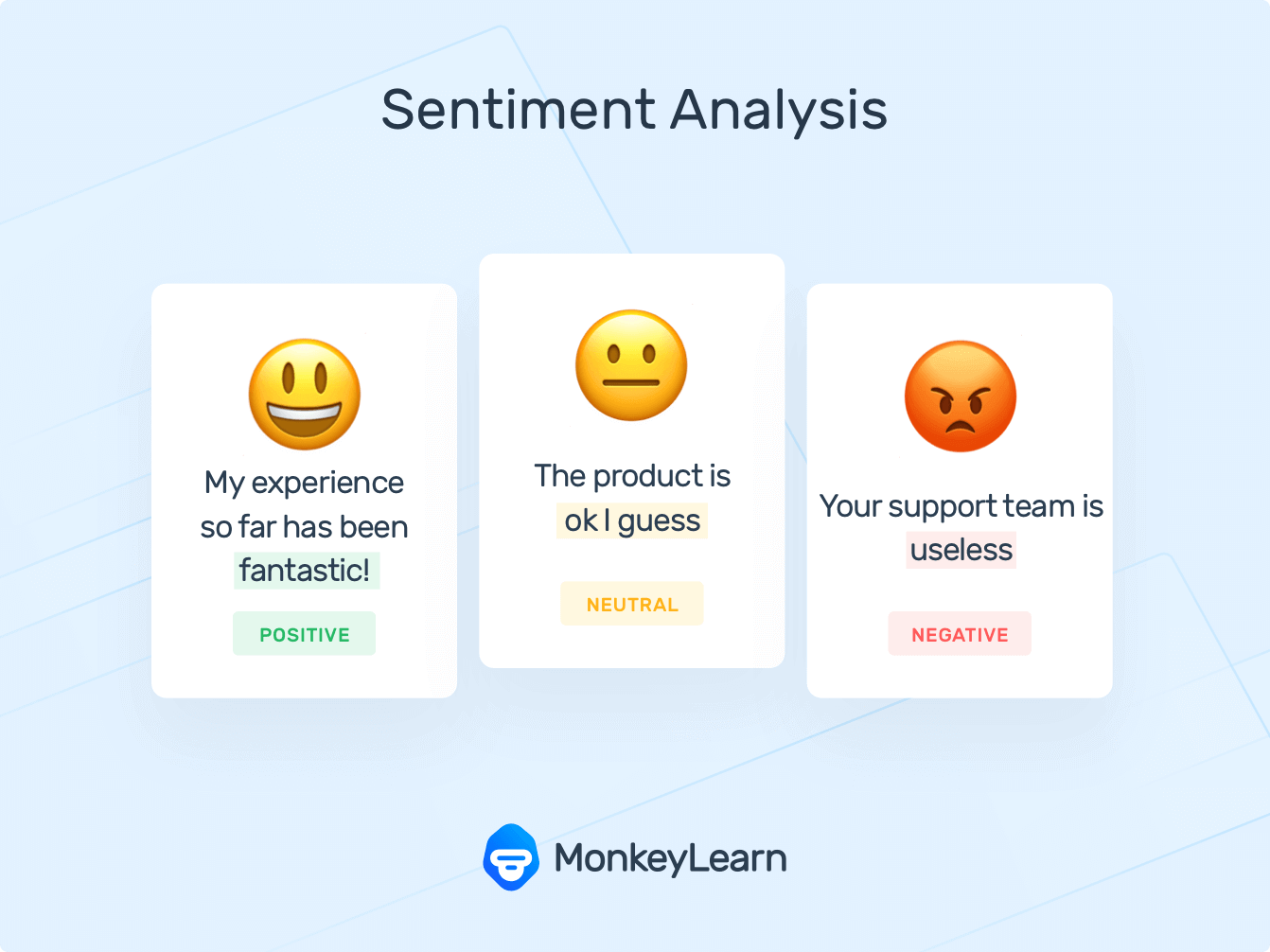What is Natural Language Processing?
Natural language processing is the artificial intelligence-driven process of making human input language decipherable to software.
Natural Language Processing Techniques
The top 7 techniques Natural Language Processing (NLP) uses to extract data from text are:
- Sentiment Analysis
- Named Entity Recognition
- Summarization
- Topic Modeling
- Text Classification
- Keyword Extraction
- Lemmatization and stemming
1. Sentiment Analysis
This is the dissection of data (text, voice, etc) in order to determine whether it’s positive, neutral, or negative.

As you can see in our classic set of examples above, it tags each statement with ‘sentiment’ then aggregates the sum of all the statements in a given dataset.
In this manner, sentiment analysis can transform large archives of customer feedback, reviews, or social media reactions into actionable, quantified results. These results can then be analyzed for customer insight and further strategic results.
Try out our sentiment analyzer to see how NLP works on your data.
2. Named Entity Recognition
Named Entity Recognition, or NER (because we in the tech world are huge fans of our acronyms) is a Natural Language Processing technique that tags ‘named identities’ within text and extracts them for further analysis.
As you can see in the example below, NER is similar to sentiment analysis. NER, however, simply tags the identities, whether they are organization names, people, proper nouns, locations, etc., and keeps a running tally of how many times they occur within a dataset.

How many times an identity (meaning a specific thing) crops up in customer feedback can indicate the need to fix a certain pain point. Within reviews and searches it can indicate a preference for specific kinds of products, allowing you to custom tailor each customer journey to fit the individual user, thus improving their customer experience.
The limits to NER’s application are only bounded by your feedback and content teams’ imaginations.
3. Text Summary
This is a fun one. Text summarization is the breakdown of jargon, whether scientific, medical, technical or other, into its most basic terms using natural language processing in order to make it more understandable.
This might seem daunting – our languages are complicated. But by applying basic noun-verb linking algorithms, text summary software can quickly synthesize complicated language to generate a concise output.
4. Topic Modeling
Topic Modeling is an unsupervised Natural Language Processing technique that utilizes artificial intelligence programs to tag and group text clusters that share common topics.
You can think of this a similar exercise to keyword tagging, the extraction and tabulation of important words from text, except applied to topic keywords and the clusters of information associated with them
5. Text Classification
Again, text classification is the organizing of large amounts of unstructured text (meaning the raw text data you are receiving from your customers). Topic modeling, sentiment analysis, and keyword extraction (which we’ll go through next) are subsets of text classification.
Text classification takes your text dataset then structures it for further analysis. It is often used to mine helpful data from customer reviews as well as customer service slogs.
6. Keyword Extraction
The final key to the text analysis puzzle, keyword extraction, is a broader form of the techniques we have already covered. By definition, keyword extraction is the automated process of extracting the most relevant information from text using AI and machine learning algorithms.
You can mold your software to search for the keywords relevant to your needs – try it out with our sample keyword extractor.
7. Lemmatization and Stemming
More technical than our other topics, lemmatization and stemming refers to the breakdown, tagging, and restructuring of text data based on either root stem or definition.
That might seem like saying the same thing twice, but both sorting processes can lend different valuable data. Discover how to make the best of both techniques in our guide to Text Cleaning for NLP.
That’s a lot to tackle at once, but by understanding each process and combing through the linked tutorials, you should be well on your way to a smooth and successful NLP application.
Thank You
Mahendran M
Helical IT Solutions

Best Open Source Business Intelligence Software Helical Insight is Here
